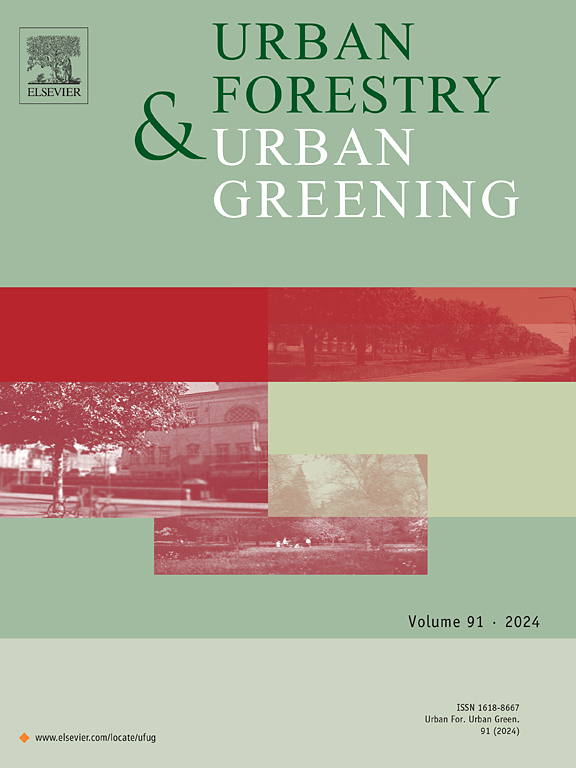圣地提供城市绿地,维持日本东京大都市鸟类的多样性
IF 6
2区 环境科学与生态学
Q1 ENVIRONMENTAL STUDIES
引用次数: 0
摘要
城市中的绿地被认为在维护城市生物多样性方面发挥着重要作用。然而,在大城市中很难创造出大片新的绿地。因此,需要对现有绿地进行保护和妥善管理,以保护城市生物多样性。在日本的大城市中,神社、寺庙和历史公园等圣地是一些常见的绿地类型。除了作为宗教场所的作用外,它们作为自然植被的长期保护区,在保护城市生物多样性方面也发挥着重要作用。在这项研究中,我们通过将东京都文京区的神社、寺庙和历史公园与城市公园进行比较,考察了它们在维持鸟类多样性方面的功能。此外,我们还进行了植被调查,以确定影响鸟类多样性的环境因素,并讨论了在各类绿地中观察到的鸟类物种的差异。研究地点之间鸟类物种组成的异质性在神社和寺庙中高于城市公园。与城市公园相比,祠庙和历史公园在繁殖季节的林鸟丰度更高,在冬季的鸟类物种丰富度更高。灌木和常绿乔木的丰富程度对鸟类多样性有积极影响。我们发现,在维持鸟类多样性方面,圣地比城市公园更重要。研究结果还表明,植被结构的差异是造成这种模式的原因之一,圣地内的小型绿地的管理方式更适合维持鸟类多样性。然而,尽管神社和寺庙具有很高的历史和文化价值,但它们也受到了近年来城市化的威胁。有必要将这些绿地作为城市生态系统的一部分加以维护和妥善管理。本文章由计算机程序翻译,如有差异,请以英文原文为准。
Sacred sites provide urban green spaces that maintain bird diversity in the megacity of Tokyo, Japan
Green spaces in cities are thought to play an important role in maintaining urban biodiversity. However, it is difficult to create large new areas of green space in big cities. Therefore, existing green spaces need to be conserved and properly managed to conserve urban biodiversity. In big Japanese cities, sacred sites such as shrines, temples, and historic parks are some of the common types of green space. In addition to their role as religious spaces, they may also play an important role in urban biodiversity conservation because of their function as long-term reserves of natural vegetation. In this study, we examined the function of shrines, temples, and historic parks in Bunkyo ward, Tokyo, in maintaining bird diversity by comparing them with urban parks. In addition, a vegetation survey was conducted to identify environmental factors that affect bird diversity, and differences in the bird species observed in each type of green space are discussed. The heterogeneity of bird species composition between study sites was higher among shrines and temples than among urban parks. Forest bird abundance was higher during the breeding season and bird species richness was higher in winter at shrines and temples and historic parks than in urban parks. Bird diversity was positively affected by the abundance of shrubs and evergreen trees. We found that sacred sites were more important than urban parks for maintaining bird diversity. The results also suggested that differences in vegetation structure are a cause of this pattern, and small green spaces in the grounds of sacred sites are managed in a way that is more suitable for maintaining bird diversity. However, shrines and temples, despite their strong historical and cultural value, are threatened by recent urbanization. It is necessary to maintain and properly manage these green spaces as part of urban ecosystems.
求助全文
通过发布文献求助,成功后即可免费获取论文全文。
去求助
来源期刊

Urban Forestry & Urban Greening
FORESTRY-
CiteScore
11.70
自引率
12.50%
发文量
289
审稿时长
70 days
期刊介绍:
Urban Forestry and Urban Greening is a refereed, international journal aimed at presenting high-quality research with urban and peri-urban woody and non-woody vegetation and its use, planning, design, establishment and management as its main topics. Urban Forestry and Urban Greening concentrates on all tree-dominated (as joint together in the urban forest) as well as other green resources in and around urban areas, such as woodlands, public and private urban parks and gardens, urban nature areas, street tree and square plantations, botanical gardens and cemeteries.
The journal welcomes basic and applied research papers, as well as review papers and short communications. Contributions should focus on one or more of the following aspects:
-Form and functions of urban forests and other vegetation, including aspects of urban ecology.
-Policy-making, planning and design related to urban forests and other vegetation.
-Selection and establishment of tree resources and other vegetation for urban environments.
-Management of urban forests and other vegetation.
Original contributions of a high academic standard are invited from a wide range of disciplines and fields, including forestry, biology, horticulture, arboriculture, landscape ecology, pathology, soil science, hydrology, landscape architecture, landscape planning, urban planning and design, economics, sociology, environmental psychology, public health, and education.
 求助内容:
求助内容: 应助结果提醒方式:
应助结果提醒方式:


